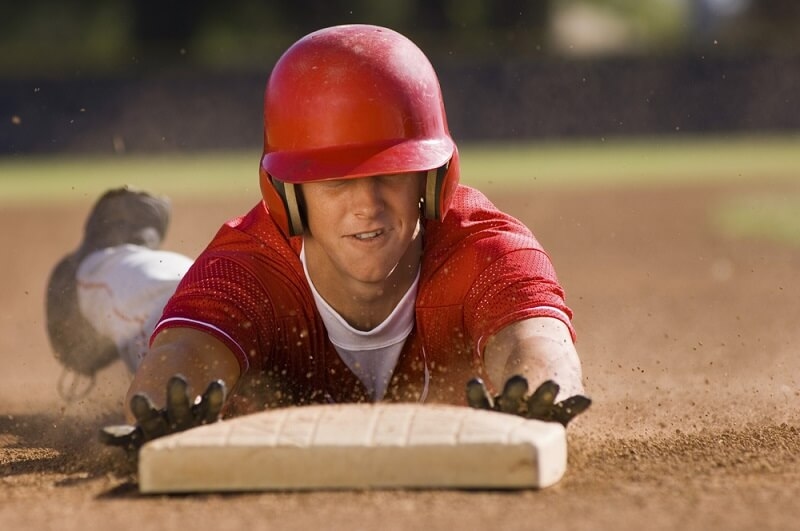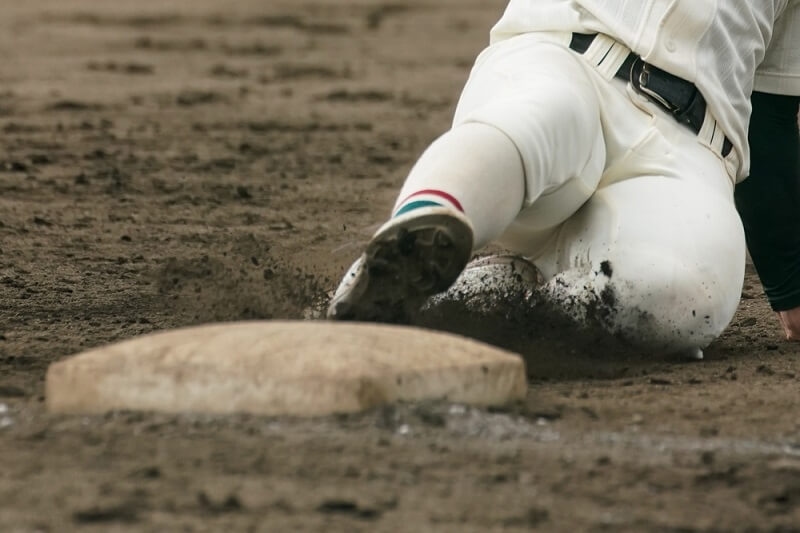
Close
Step onto the baseball diamond with us, as we dive headfirst into the art of the slide. That heart-stopping, dust-raising, game-changing maneuver is more than a simple move - it's an intricate dance of timing, speed, body control, and technique.
In this blog, we're breaking down this thrilling aspect of the sport, shedding light on everything from the physics involved to the pro tips that'll turn your basic slide into a smooth, crowd-cheering spectacle. Whether you're a budding player or a seasoned pro, strap on your cleats, and let's perfect that baseball slides together.

The baseball slide is an integral component of the game because it helps players reach bases more quickly and safely while also protecting them from being tagged by fielders. This is more than just a tactical shift; it has the power to completely change the outcome of the game.
Let's have a look at the different kinds of slides. Two of the most prevalent are the head-first and feet-first slides. A feet-first slide involves leaning back and throwing one's legs forward in order to reach the base safely. It's a great way to keep track of everything and keep an eye on the ball when you need to overrun a base. In contrast, a head-first slide is a player diving headfirst toward the base, arms extended in an attempt to touch the base as quickly as possible. It could provide a marginal increase in speed but at the expense of increased danger.
But baseball isn't played with just two slides. The pop-up slide allows a player to slide into the base and swiftly stand, ready to move to the next base, and the hook slide involves a player sliding feet-first but hooking one leg aside to avoid a tag. Each type of slide calls for a different set of body mechanics and can be used strategically in different contexts.
The science of baseball and its art form, sliding, are inextricably intertwined. By learning these rules, you can improve your slide and reduce the likelihood of getting hurt.
The idea of momentum is fundamental to a smooth slide. A player's momentum increases as they run. With a successful slide, a player is able to channel their forward momentum in a horizontal direction, helping them speed toward home plate. This highlights the importance of the player's pace and the slide's initiation angle.
The mechanics of the human body are also crucial. Maintaining balance and control while sliding calls for intricately coordinated motions of the knees, hips, and back. A player's speed and control when sliding depend on how well they can manipulate their body.
Last but not least, the slide has a significant effect on both speed and safety. By lowering their center of gravity and maintaining their pace, a well-executed slide makes it more difficult for fielders to tag runners out. While stopping suddenly or crashing into the base both increase the danger of harm, sliding provides a controlled way to decelerate.

Now, let's delve into the specifics of the most common type of slide: the feet-first slide:
Preparation is key to a successful feet-first slide. As you run, it's vital to make a conscious decision whether to slide or not based on the fielder's position, the location of the ball, and your distance from the base. Your body should be ready for the action - your weight shifting towards the balls of your feet, preparing for the transition.
1. As you approach the base, determine which leg will be extended first - typically, this would be your non-dominant leg.
2. Start by bending your knees, lowering your center of gravity. Sit back as if you're sliding into a chair, extending one leg straight towards the base.
3. The other leg should be bent, the foot off the ground, to brace your fall and guide your slide.
4. Your upper body leans back slightly, hands lifted to avoid injury.
5. As you slide, aim to hit the ground with your thigh, reducing the impact on your more vulnerable body parts.
Recognizing common baseball mistakes is crucial for refining skills and achieving success in the game. One common error is waiting too long to start sliding. Injuries from sudden stops are a real possibility if this happens. Start your slide when you're a safe distance from the base, preferably 3 or 4 steps away from it.
It's also typical to make the mistake of not lifting the hands during the slide. If you do this, you risk spraining or breaking a finger. Keep your hands up at all times, but never tense. Finally, many players have the bad habit of straightening their bent legs, which results in a bouncy slide. Keeping the bent leg bent makes for a more controlled and comfortable sliding since it acts as a guide.

Baseball rules and tips serve as the foundation of the game, guiding players and umpires to ensure fair play and a thrilling sporting experience.
Learning from the masters is one of the best ways to elevate your game. Let's look at a few tips from renowned baseball players:
1. Derek Jeter - Known for his signature "jump-throw," Jeter advises players to be confident in their slides and always aware of their surroundings. He believes that the best slides come from instinct rather than overthinking.
2. Ichiro Suzuki - Ichiro, famed for his aggressive baserunning, stresses the importance of the mental game. He encourages players to visualize their slides, believing that mental imagery helps execute perfect slides during the game.
3. Rickey Henderson - The stolen base king, Henderson, emphasizes the importance of speed and timing. He suggests practicing the slide with a sense of urgency, which can make a significant difference in a real-game scenario.
1. Pete Rose's head-first slide - Known as "Charlie Hustle," Rose was famous for his daring head-first slides. Analyzing his technique, we see the advantage of reaching the base faster. However, it's also important to note the increased injury risk associated with this aggressive style.
2. Jackie Robinson's hook slide - Robinson's hook slides were a thing of beauty. He would initiate his slide slightly past the base, hooking his leg around to touch the base while evading the fielder's tag. This showcases the effectiveness of the hook slide when done correctly.
1. Dave Roberts, Manager, Los Angeles Dodgers - Roberts emphasizes the importance of practicing slides regularly. He believes that it's not just about the execution but also about knowing when to slide. Regular drills can help players make these split-second decisions during the game.
2. Ron Washington, Third Base Coach, Atlanta Braves - Washington advocates for mastering the feet-first slide before moving on to more complex techniques. He stresses that safety should always be a priority and that the feet-first slide offers a good balance of speed and safety.
Each piece of advice offers valuable insights into the art of the baseball slide. As you incorporate these pro tips and practice, remember that consistent effort and focus can significantly enhance your sliding technique.
You may also like: Baseball Fan Etiquette: Team Spirit Without Crossing Lines
To wrap up, mastering the baseball slide involves understanding its nuances, practicing diligently, and learning from the pros. Whether it's the feet-first or the head-first slide, each technique offers unique advantages. Incorporate these insights into your game, stay safe on the field, and remember, perfecting your slide could be your game-changing move.
This content was created by AI